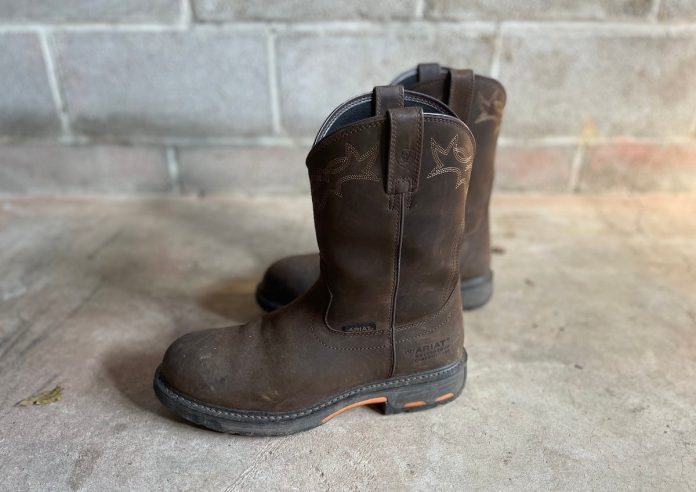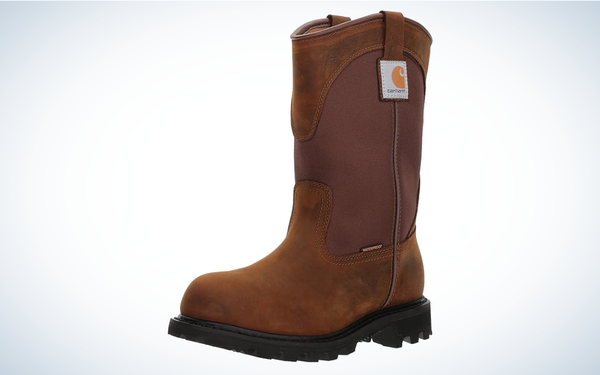We may earn revenue from the products available on this page and participate in affiliate programs. Learn more ›
Whether your job takes you and your work boots into a muddy field or onto a construction site, if you work outdoors, you’re bound to face wet conditions now and then. When you do, nothing will zap your energy and put you in more discomfort than wet feet. That’s why it’s so crucial to have a good set of waterproof boots if you work out in the elements. Unfortunately, there are a lot of pretenders out there that claim to be waterproof but leave your socks sopping wet when put to the test.
Quality waterproof boots for work are designed to endure wet conditions and will be made of watertight full-grain leather with waterproofing construction methods that include welted seams, gusseted tongues, and waterproof liners. A good set of waterproof boots will also be comfortable to wear all day long with polyurethane foam midsoles that provide ample shock absorption along with cushioned footbeds to support the arches and prevent soreness.
If your job takes you into wet conditions, then keep reading to find out more about the best waterproof work boots to keep your feet dry and comfortable.
How We Made Our Picks
If your job takes you into wet conditions, you’ll certainly want a waterproof set of boots to ensure your feet stay dry. But while waterproofing is crucial, your feet also need to be comfortable too. I kept these factors in mind while making my selections for this guide:
- Waterproof: Regardless of how much cushion or support a boot provides, if your feet are wet, you’re going to be uncomfortable. I chose boots that use construction techniques and materials that are proven to keep a boot watertight. I chose full-grain leather over top-grain leather; welted seams as opposed to cement seams; and waterproofing features, such as gusseted tongues and rivets.
- Comfort: Your feet should be comfortable as well as dry, so I selected boots with comfort features. My selections have high-density foam midsoles that provide ample rebound and shock absorption and cushioned footbeds that support the arches while protecting the soles of the feet.
- Tread: If you’re working in wet conditions, slipping is a constant hazard. Keeping that in mind, I chose boots for mucky conditions that have deep tread and a lug sole. I also included boots with a wedge sole and tight siping on the tread for those whose work involves walking across wet smooth surfaces.
Best Waterproof Work Boots: Reviews and Recommendations
Specs
- Sizes: 7-14
- Materials: Full-grain leather with rubber outsole
- Shaft Height: 6 inches
Pros
- Waterproof full-grain leather and welt construction
- Gel footbed
- Compression pads in the outsole add shock absorption
Cons
- Outsole is not ideal for muddier terrain
The Wolverine Buccaneer’s ability to marry comfort with waterproof construction makes them the best all-around work boot you can strap on your feet for a full day of walking and standing in wet conditions. Wolverine goes with full-grain leather for this work boot, eliminating the seams found in top-grain leather that can cause it to take on water. Welted seam construction not only makes the boots more watertight between the outsole and upper but also more durable, which is important for a boot that is on the pricier end of the spectrum. Inside, the Buccaneer’s come equipped with a mesh lining that helps wick water away from your feet to prevent sweat from building up in the boot.
Of course, a good outdoor work boot should be comfortable as well as waterproof. This is where the Buccaneer separates itself from the average work boot, thanks to Wolverine’s well-regarded Multishox system. Multishox places compression pads across the outsole, focusing particularly on the pressure points in the heel and ball of the foot to provide excellent shock absorption and rebound. The boots also have more arch support than a standard work boot. Couple that with a thick midsole made of high-density polyurethane foam and a gel footbed with ample arch support and you have a very comfortable work boot. You’d be hard-pressed to find a work boot with more features designed to keep your feet comfy and dry all day.
Specs
- Sizes: 7-14
- Materials: Genuine full-grain leather with rubber outsole
- Shaft Height: 10 inches
Pros
- Full-grain-leather construction and welted seams
- Waterproof membrane
- Attractive cowboy boot style
Cons
- Expensive
- Don’t provide as much ankle support as lace-up boots
These boots found their way on this list due to their waterproof design and an impressive lineup of features that make them comfortable for all-day wear. Ariat keeps these boots watertight with a waterproofing membrane that keeps water out while still being breathable enough to allow water vapor from your sweaty feet to escape. We also like the 10-inch shaft, which prevents water from finding its way into the boot opening even when sloshing through deeper mud and puddles.
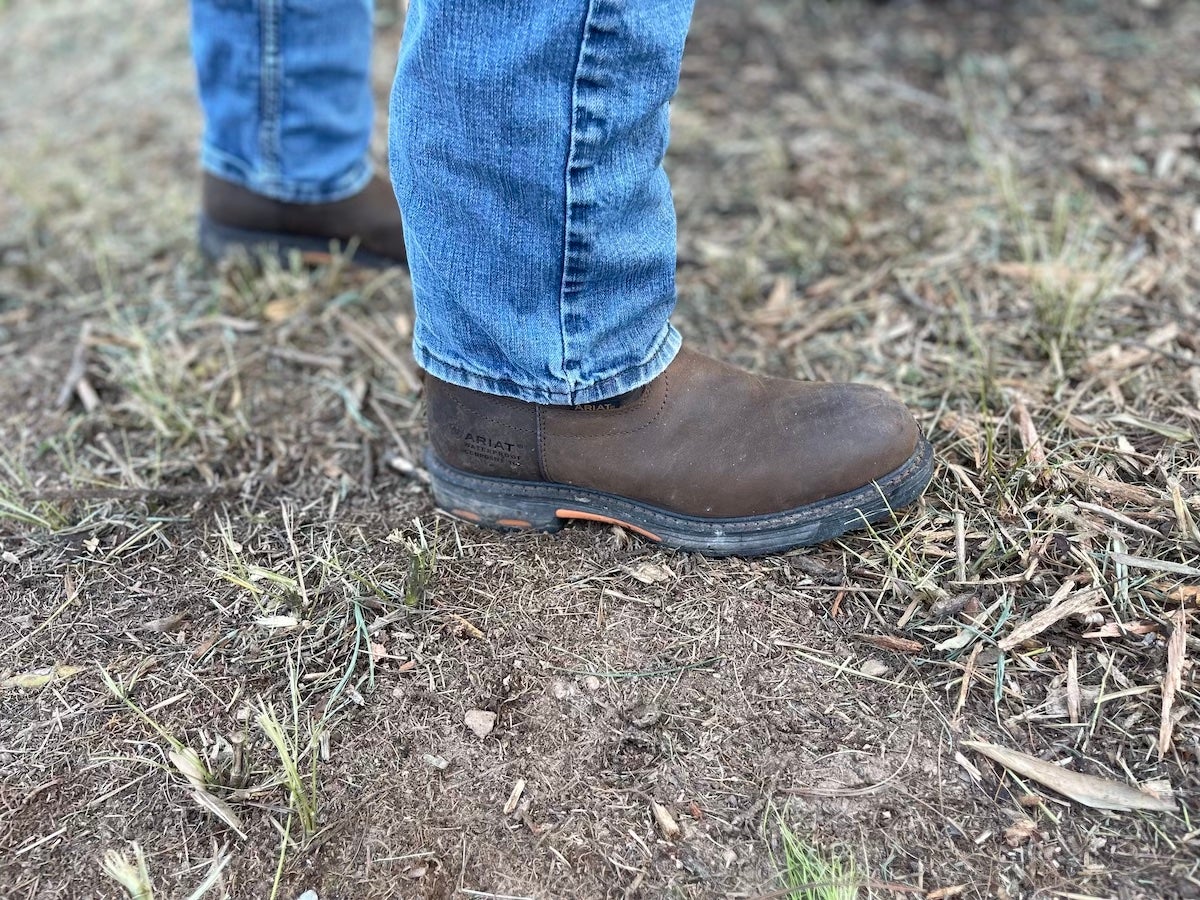
Ariat work boots are high-end and it shows with their selection of materials. Unlike boots that use top grain leather, which consists of pieces of animal hide sewn together, creating seams that water can reach, the WorkHogs use full grain leather, which is seamless, and therefore better equipped to keep water out. The boots also feature welted seams, which last longer and make the boots more watertight than cement seam construction. They’re one of the more attractive waterproof work boots thanks to their cowboy boot design that features western stitching on the shaft.
In addition to its waterproofing methods, Ariat also loads the WorkHogs with its highly regarded comfort tech, which includes a high-density foam insole for shock absorption. The boots also come equipped with a removable cushioned insole and Ariat’s U-Turn entry system, which makes the boots easier to put on and a wide shank that adds stability.
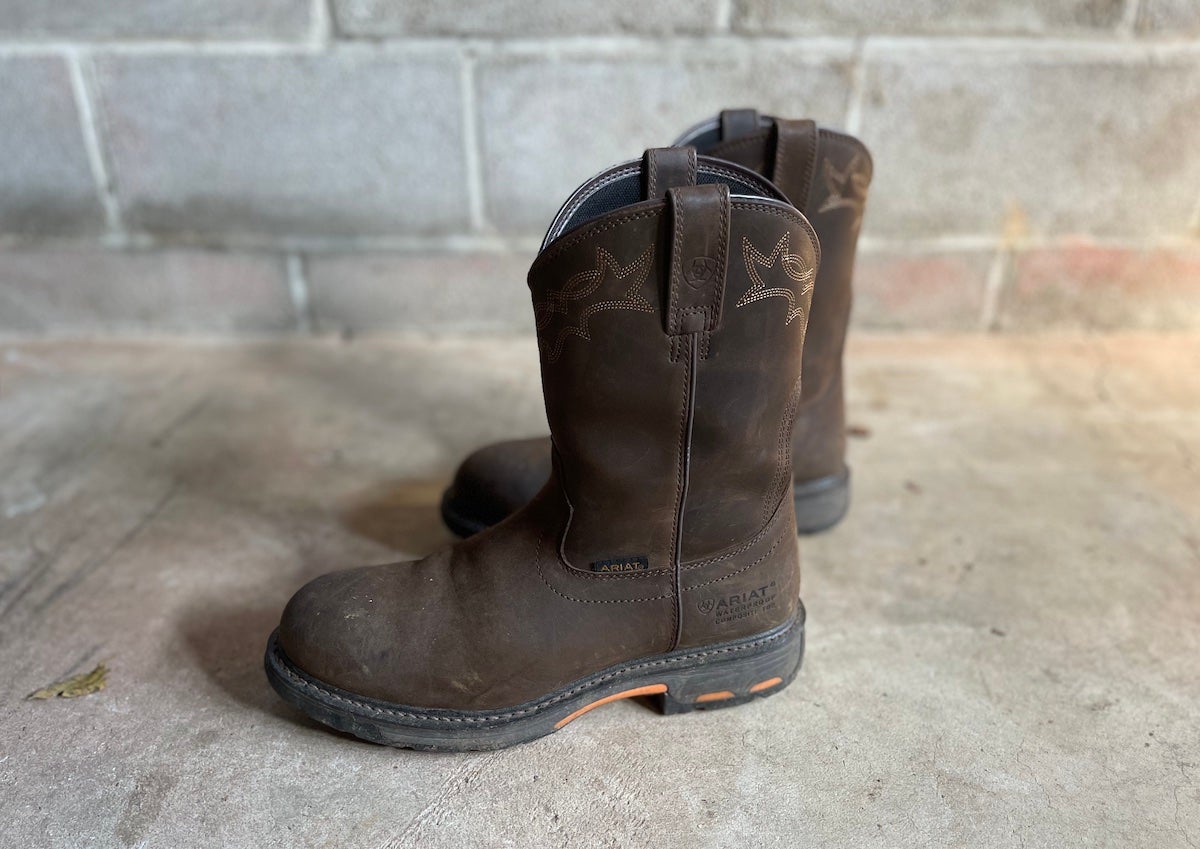
When we tested them, we liked how easy it was to pull on the boots. They’re incredibly comfortable with no breaking-in period required—they were good to wear right out of the box. And they offered plenty of comfort and cushioning during hours of yard work and house projects. Our male tester liked the wider cut that gave his feet room to move without any pinching or chafing. The toe box is protective while the sole has plenty of traction on slippery surfaces.
Additionally, the boots are waterproof yet breathable. Our tester’s feet stayed dry both from outside water and from potential sweat while working. The WorkHogs are very durable and tough, handling any task we threw at them with ease. Even after hours and hours of wearing them almost daily, they show no signs of wear or fading. These are boots that will last. -Amanda Oliver, executive editor of commerce
Best Steel-Toe: Timberland PRO Direct Work Boot
Specs
- Sizes: 7-15
- Materials: Nubuck leather with sealed seams and rubber outsole
- Shaft Height: 6 inches
Pros
- PRO comfort system is ideal for all-day wear
- Insulated for cold weather
- Deep tread for muddy conditions
Cons
- Lower-quality nubuck leather construction
Timberland’s aptly named PRO workboot comes equipped with the safety features required for some workplaces. First and foremost, the boost comes equipped with a steel safety toe for max crush protection, making them an ideal steel toe boot for jobs that require one to work with heavy machinery.
And, although the Timberland PRO’s use nubuck leather, which has more seams than full-grain leather, the seams are sealed, giving the boots their ability to keep water at bay. The boot shaft rises 6 inches from the arch, allowing for good freedom of movement while keeping feet dry in muddy conditions. The boots also have 200 grams of insulation, making them suitable for working outdoors in cold weather.
In addition to providing ample traction with a heavy tread, the thick sole also houses a dense layer of high-density foam that provides ample shock absorption and rebound, making the PRO comfortable for all-day use. Inside the footbed offers a significant amount of support for those with high arches. The insole also has an antimicrobial treatment that keeps the boots from getting smelly.
Specs
- Sizes: 5-16
- Materials: Rubber and waterproof neoprene
- Shaft Height: 15.5 inches
Pros
- Waterproof rubber construction
- Tall shaft for great coverage
- Neoprene shaft adds comfort and mobility
Cons
- Not suitable for indoor use
These boots may not be as versatile or comfortable as those with lower shafts leather construction, but if you need max protection in wet and messy locations, there is no other choice. The boots eschew leather for a material that’s more waterproof, rubber, ensuring you can plunge into deeper water without having to worry about getting your socks wet. The shaft rises 15.5 inches from the arch, providing ample coverage for the calf, so you can venture into deeper waters without worry about getting wet.
Muck Boots design the upper part of the shaft with waterproof neoprene, which stretches to conform to the calf, preventing a gap between the boot and leg that can allow water in while providing more support than your standard pull-on style work boot.
Understanding that sweat can make you just as wet, Muck Boots have also equipped the chores with a mesh lining that wicks away water vapor. The outsole consists of a thick lug-style tread with wide caps that grip loose and sloppy terrain well while also shedding debris easily, preventing the treads from becoming overwhelmed. The soft rubber soles also do a good job of gripping to smooth slick surfaces. Muck Boots also smartly designs a kick rim on the outsole for hands-free removal.
Specs
- Sizes: 6-11
- Materials: Oil-tanned leather with nylon upper and rubber sole
- Shaft Height: 10 inches
Pros
- Waterproof rubber construction
- Tall shaft for great coverage
- Lug bottom rubber soles offer better traction and stability
Cons
- Looser fit isn’t as snug on your feet
With a design that’s specific to women’s feet, along with a high shaft and a broad sole, these waterproof Wellington work boots are an ideal pick for women whose work takes them into wet conditions. They have the rugged durability Carhartt workwear is famous for, with high quality oil-tanned leather, reinforced fabric and seams, and a completely waterproof exterior. They’re also ASTM-compliant.
From the first time I put them on, I knew I was a fan. The pull-on Wellington design makes them easy to slip on—no pesky laces—and offers ample room around the calf, which allows for freedom of movement along with space for tucking in bootcut jeans or bibs. I like that the 10-inch shaft is tall enough to protect my legs yet not so tall that it hits my knees or feels restrictive.
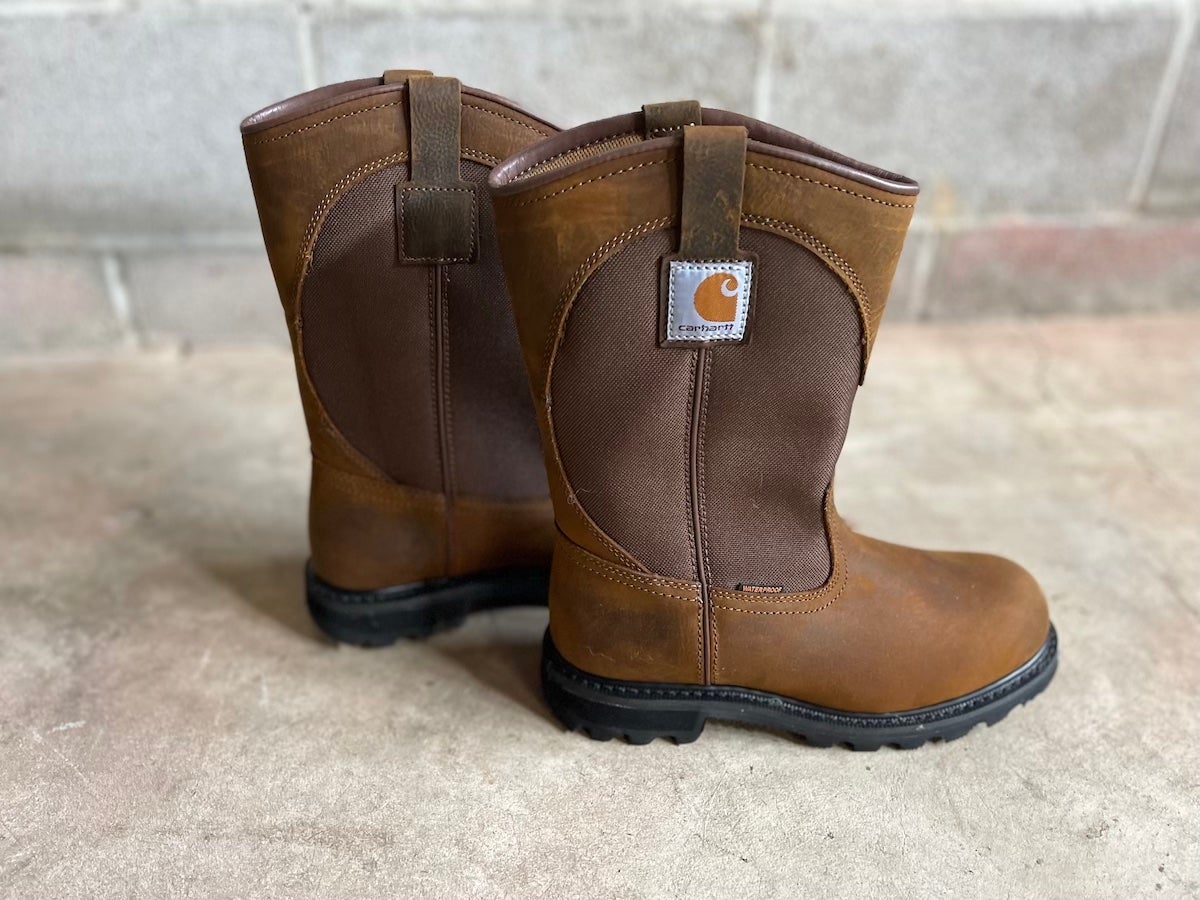
I can wear these boots for hours, whether I’m trekking through the woods in our backyard or helping my husband with DIY renovations around the house. The insole is well-cushioned and sweat-wicking, so my feet don’t get sore or sweaty. The boots are fully waterproof—I never had any issues with leaking—and the rubber soles gave me superior traction. I’ve never once slipped in them, even on wet concrete floors. -AO
What to Consider When Choosing Waterproof Work Boots
Materials
It goes without saying that a good set of waterproof work boots should keep your feet dry. Just how waterproof a work boot comes down to a few factors. While most waterproof work boots are made of leather, not all leather is created equal. Whereas cheaper top-grain leather is made up of multiple pieces of animal hyde sewn together, full-grain leather is one single piece of hyde. Since full-grain leather lacks the seams that can allow water to infiltrate the boot, it’s a better, though more expensive, type of leather for a waterproof work boot.
A good waterproof work boot should also have an interior lining that’s waterproof, ensuring water can’t find its way through the tongue opening when stepping into deeper puddles. This lining should also allow water vapor to escape, preventing your feet from becoming drenched in sweat.
Construction
How the boot is constructed also determines just how waterproof and durable it is. Good waterproof work boots should have welted seams, identifiable by the stitching between the outsole and upper. This construction method prevents water from finding its way between the outsole and boot upper. A welted seam will also last significantly longer than the cement construction found on cheaper work boots.
Shaft Height
The height of the boot shaft, which is measured from the arch of the boot to boot opening ranges from 6 inches, which offers moderate coverage up to 15 inches which covers the entire ankle and calf up to just below the knee. While a high shaft will provide more coverage and allow you to venture into deep-standing water and mud, it will also limit your mobility, making them less comfortable to wear for long periods than a boot with a lower shaft.
Comfort
A work boot that keeps your feet dry isn’t of much use unless it also keeps them comfortable through a long workday. As with conventional work boots, waterproof models use the sole to cushion the feet. Air pockets on the outsole and high-density foam on the midsole absorb shock and provide rebound, helping to reduce leg fatigue. A good work boot will also have a footbed of either foam or gel that provides cushioning that prevents the soles of the feet from getting sore over long periods of walking or standing.
FAQs
Q: How long do waterproof boots stay waterproof?
That depends on the type of boot. Boots with a waterproof lining should stay waterproof through the life of the boot. Boots that use a weatherproof spray or treatment on the outer part of the boot usually need to be reatreated about once a month with the waterproof spray to ensure they remain waterproof. Waterproof boots with full-grain leather construction and welted seams will stay watertight longer than those with lower quality materials, such as top grain leather and cement seams.
Q: What is the difference between Gore-Tex and waterproof boots?
Gore-Tex is an advanced material that uses laminated liners and special seam sealing to create a waterproof barrier in boots. In addition to being lightweight, GoreTex is also breathable, which means it allows water vapor from sweat to escape the boot. GoreTex also holds its waterproof qualities longer than other materials. These qualities make it superior to other types of waterproof materials, which is also why it costs considerably more.
Q: What makes a work boot waterproof?
There are several components that make a leather work boot waterproof. Most leather work boots have a waterproof liner that keeps getting dry even if the leather becomes saturated from being submerged in a bundle. The leather might also be oiled or treated with a waterproof spray. Work Boots also have gusseted tongue that eliminates any opening between the tongue and upper that could allow water to pass through into the boot. A waterproof boot might also use raised eyelets instead of punched holes for laces to keep the boots watertight. The sole of a waterproof boot will also be attached using either waterproof glue or stitching.
Q: Can I waterproof my work boots?
There are a few methods for waterproofing work boots, the most effective of which is to use wax, which you massage into the boot. The wax protects and nourishes the leather while resisting water and lasts for a fair amount of time before needing to be reapplied. An easier method involves spraying the boots with a silicone sealant. While this method can be completed in minutes, iot doesn’t last as long and may need to be reapplied weekly if the boots see daily use. In addition to a spray or wax, you should also apply a seam sealer around the seam between the outsole and boot, ensuring now water can pass through that seam.
Q: How much do waterproof work boots cost?
Waterproof boots range in cost from as little as $70 to $200 or more. As with most things, you get what you pay for when it comes to a set of waterproof work boots. While cheaper work boots may save you money in the short term, they will likely lose their waterproofing much sooner than a pair or high quality waterproof boots, forcing you to replace them more often. With that in mind, expect to pay around $150 for a quality set of waterproof boots.
Best Waterproof Work Boots: Final Thoughts
When deciding on a pair of waterproof boots, it’s crucial to keep in mind the materials and waterproof construction that the boot employs as well as comfort features in the insole and midsole. Wolverine’s Buccaneer work boot combines high-end waterproof construction with a gel footbed and padded outsole to create a waterproof boot that will keep your feet dry and comfortable in wet conditions. Those working in more extreme conditions should consider Muck Boots’s Chose Classic work boot, which provide max coverage with a tall shaft and waterproof rubber construction.
Why Trust Us
For more than 125 years, Field & Stream has been providing readers with honest and authentic coverage of outdoor gear. Our writers and editors eat, sleep, and breathe the outdoors, and that passion comes through in our product reviews. You can count on F&S to keep you up to date on the best new gear. And when we write about a product—whether it’s a bass lure or a backpack—we cover the good and the bad, so you know exactly what to expect before you decide to make a purchase.

